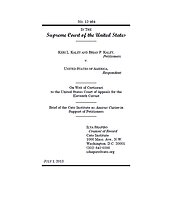Kaley v. United States
Learn more about Cato’s Amicus Briefs Program.
Federal criminal defendants must fight a battle against the largest and most powerful organization in history, the U.S. government. At the very least, hopefully, they have a trusted attorney to fight with them. That right of criminal defendants to choose their own lawyers is guaranteed by the Sixth Amendment and ensures the integrity of the adversarial justice process. Yet prosecutors are increasingly using a procedure called “asset forfeiture”—which freezes assets suspected of being tied to crime—in order to deny defendants the funds they need to retain the lawyer of their choice. In January 2005, Kerri Kaley, then a sales representative with a New York-based medical device company, was informed that she was the target of a grand jury investigation in Miami. She was suspected of stealing prescription medical devices from hospitals and selling them on the black market. Kerri and her husband Brian (also under investigation) hired counsel to represent them in what turned out to be a two-year investigation. During that period, their lawyers interviewed witnesses, reviewed countless documents, researched legal issues, and conferred with the prosecutors. To pay their attorneys, the Kaleys took a home equity line of credit on their house and bought a certificate of deposit. In 2007, the grand jury returned indictments, accompanied by asset forfeiture orders restraining the Kaleys’ money. Because they had been indicted, the money was said to be criminally “tainted.” These asset-restraining orders were obtained without the Kaleys’ lawyers present (called an ex parte hearing). The Kaleys challenged the freezing of their assets, arguing that, under the Due Process Clause of the Fifth Amendment, they were entitled to a pretrial adversarial (not ex parte) hearing where they could contest the charges against them. They argued that their constitutional claim is particularly strong because the seized money was necessary to retain their chosen lawyers. The lower courts disagreed, however, holding that the only adversarial hearing the Kaleys were entitled to wastheir trial—the same trial for which where they can’t afford the long-serving counsel of their choice. Now at the Supreme Court, the Kaleys hope to vindicate the right to retain counsel of choice. Indeed, the U.S. Court of Appeals for the Eleventh Circuit is an outlier from the overwhelming majority of federal appellate courts, which use a more demanding test for such claims. In support of the Kaleys, Cato has filed a brief arguing that the stringent test developed in a 1976 case called Mathews v. Eldridge should be used to determine the scope of the Kaleys’ hearing. Under Mathews, where the government seeks to restrain contested assets that would otherwise be used to retain counsel of choice, an adversarial hearing is required in which defendants can challenge the indictment used to support forfeiture. Because the expansion of forfeiture has given rise to well-documented abuses, the risk of error is great and the individual interests at stake are highly compelling. Ex parte hearings are insufficient to reduce the probability of error and the countervailing government interests are insufficient to tip the balance. Ultimately, the right to counsel of choice preserves the integrity of the legal process by ensuring that the defendant, not the government, controls whom he trusts with his case.

This work is licensed under a Creative Commons Attribution-NonCommercial-ShareAlike 4.0 International License.



